Syngonium Pink Splash, also known as Arrowhead Plant, is a popular houseplant known for its attractive foliage. It belongs to the Araceae family and is native to tropical regions of Central and South America. The plant gets its name from its arrowhead-shaped leaves that display beautiful shades of pink, cream, and green, making it a sought-after beginner-friendly choice for indoor gardening enthusiasts.
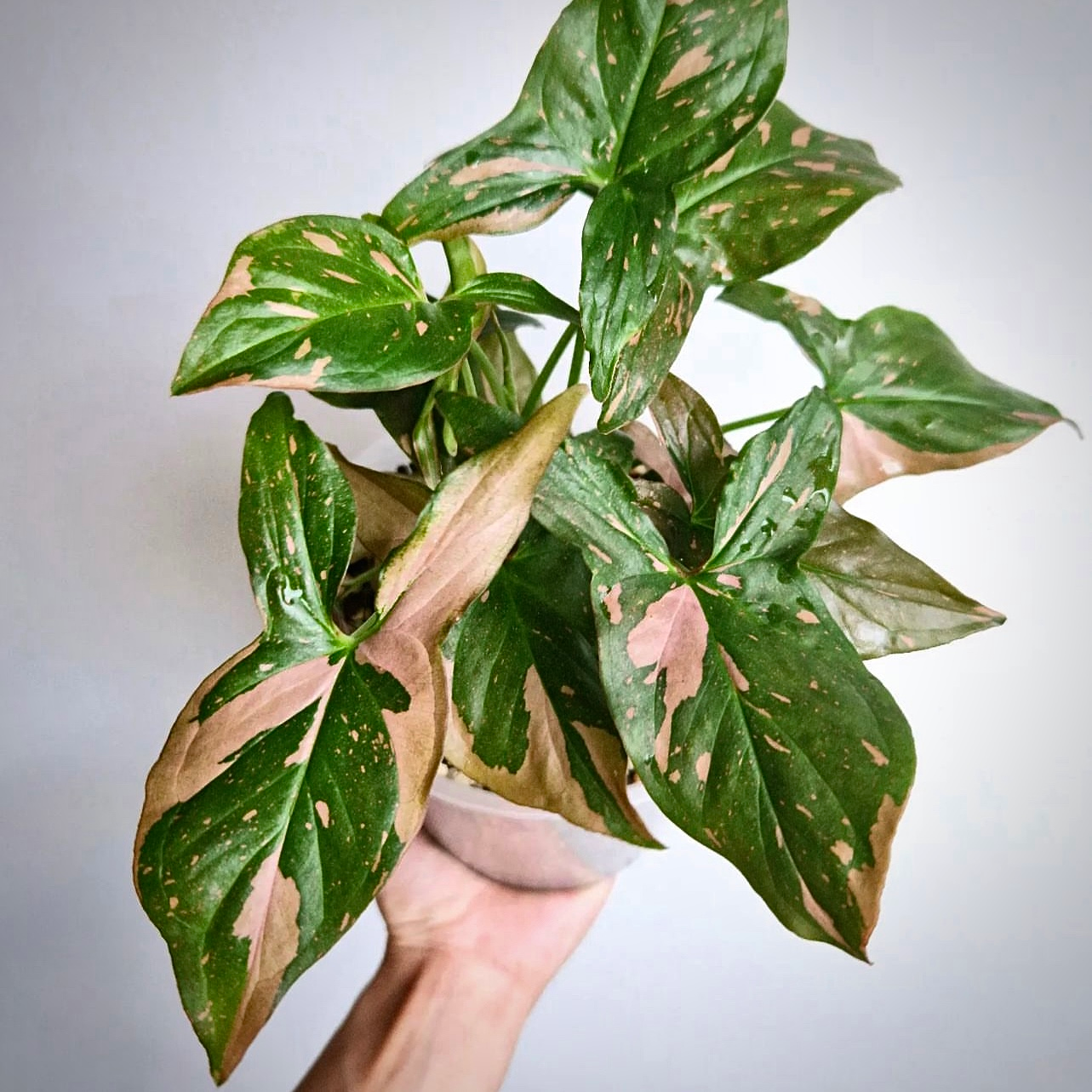
Everything You Need to Know about Pink Splash Syngonium
Pink Splash Syngonium, scientifically known as Syngonium podophyllum ‘Pink Splash,' is a popular cultivar of the Syngonium podophyllum species. It is a tropical plant that belongs to the Araceae family, native to the rainforests of Central and South America. The plant is characterized by arrowhead-shaped leaves with variegated patterns of pink, cream, and green.
The name ‘Pink Splash' refers to the pink splashes or blotches that adorn the leaves, creating a striking contrast against the green and cream background. The variegation is more prominent on young leaves and tends to fade as the leaves mature. The plant has a trailing or climbing growth habit, making it suitable for hanging baskets or using as trailing indoor plants.
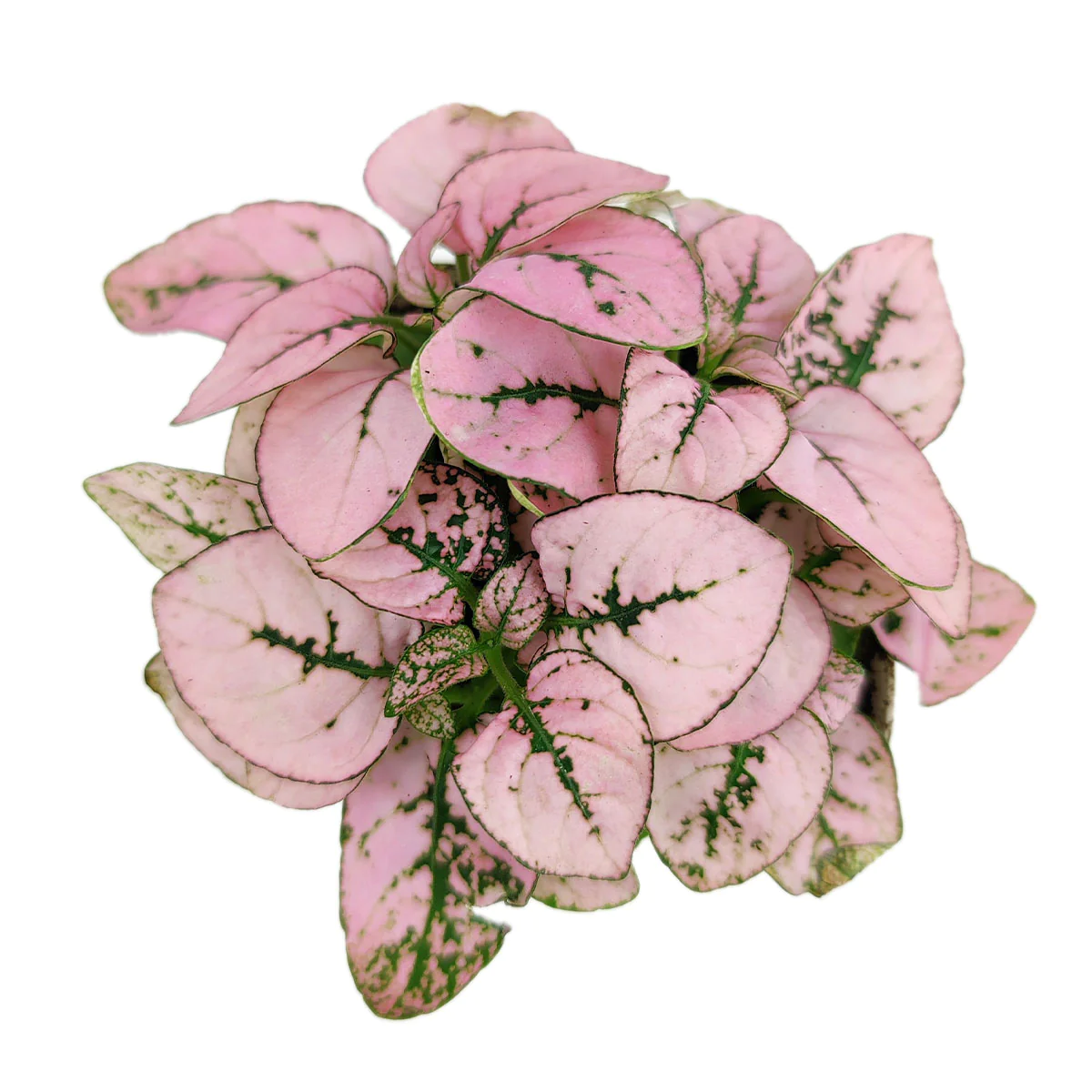
One of the fascinating features of Pink Splash Syngonium is its ability to change its leaf shape as it matures. Young leaves start as small and lobed, resembling an arrowhead, hence its common name “Arrowhead Plant.” As the plant grows and matures, the leaves transform into larger, more elongated shapes, with distinct lobes and edges. This transformation adds an interesting dynamic to the plant's appearance.
Syngonium Pink Splash Plant Basics:
| Common Name: | Arrowhead Syngonium, Pink Splash Syngonium |
| Botanical Name: | Syngonium podophyllum Pink Splash |
| Plant Type: | Tropical |
| Size: | 3-6 feet in height with a 2-foot spread |
| Light: | Low light tolerant but thrives in medium to bright indirect light |
| Soil: | Loose potting soil, slightly acidic |
| Water: | Deep infrequent watering, allow to dry between waterings |
| Vulnerabilities: | Overwatering, low humidity, pests, and cold |
| USDA Growing Zones: | 9-11 |
Syngonium Pink Splash Plant Care Guide
Proper care is crucial for the health and well-being of your Syngonium Pink Splash plant. Here are some essential tips to help you provide the ideal conditions and care for your plant, ensuring its growth and vibrancy.
Soil Guide
For optimal growth, choose well-draining soil for your Syngonium Pink Splash plant. Use a mix of peat moss, perlite, and indoor plant potting mix to ensure proper drainage and moisture retention. Aim for a slightly acidic to neutral soil with a pH of 5.5 to 7.0.
Watering Needs
Proper watering is crucial for the health of your Syngonium Pink Splash plant. Water thoroughly, allowing the top inch of soil to dry out between waterings. Adjust the watering frequency based on humidity, temperature, and season. Use room temperature water and aim to slightly under-water rather than over-water the plant to maintain its well-being.
Amount of Light
Syngonium Pink Splash plants thrive in bright, indirect light but can also tolerate moderate to low light conditions. Place the plant where it can receive ample bright, indirect light, avoiding direct sun to prevent leaf damage. Adjust the plant's placement as needed to maintain optimal light conditions and consider rotating it for even growth.

Temperature & Humidity Needs
Syngonium Pink Splash plants prefer temperatures between 60°F (15°C) and 75°F (24°C) and appreciate higher humidity levels of around 50% or higher. Avoid exposing them to cold drafts or temperatures below 55°F (13°C) to prevent leaf damage or stunted growth.
Fertilizing
Feed your plant every 4-6 weeks during the growing season using a balanced, water-soluble fertilizer with equal proportions of nitrogen, phosphorus, and potassium.
Pruning Method
Pruning your Syngonium Pink Splash plant helps maintain its shape, promote bushier growth, and remove any dead or damaged foliage. Use clean and sharp pruning shears or scissors to trim back long or leggy stems, cutting just above a node or leaf. Regularly inspect the plant for any signs of disease or pests, and promptly remove affected leaves or stems. Avoid excessive pruning, as it can weaken the plant.
Syngonium Pink Splash Plant Propagation
To propagate your Syngonium Pink Splash using stem cuttings, follow these steps. Select a healthy stem with at least two nodes and a few leaves. Cut the stem just below a node using clean and sharp scissors or pruning shears. Remove the lower leaves, leaving a few at the top.
Place the cutting in a container with water or a well-draining potting mix, ensuring the nodes are submerged or buried. Keep the cutting in a warm and humid environment with indirect light, misting the leaves occasionally. Roots should develop in a few weeks, at which point the cutting can be transferred to a pot with soil.

Pink Syngonium Varieties
In addition to the Pink Splash variety, there are several other Syngonium cultivars with pink or pink-tinged foliage. Some popular pink varieties include
Syngonium ‘Pink Allusion': This variety features leaves that are predominantly pink with green veins.
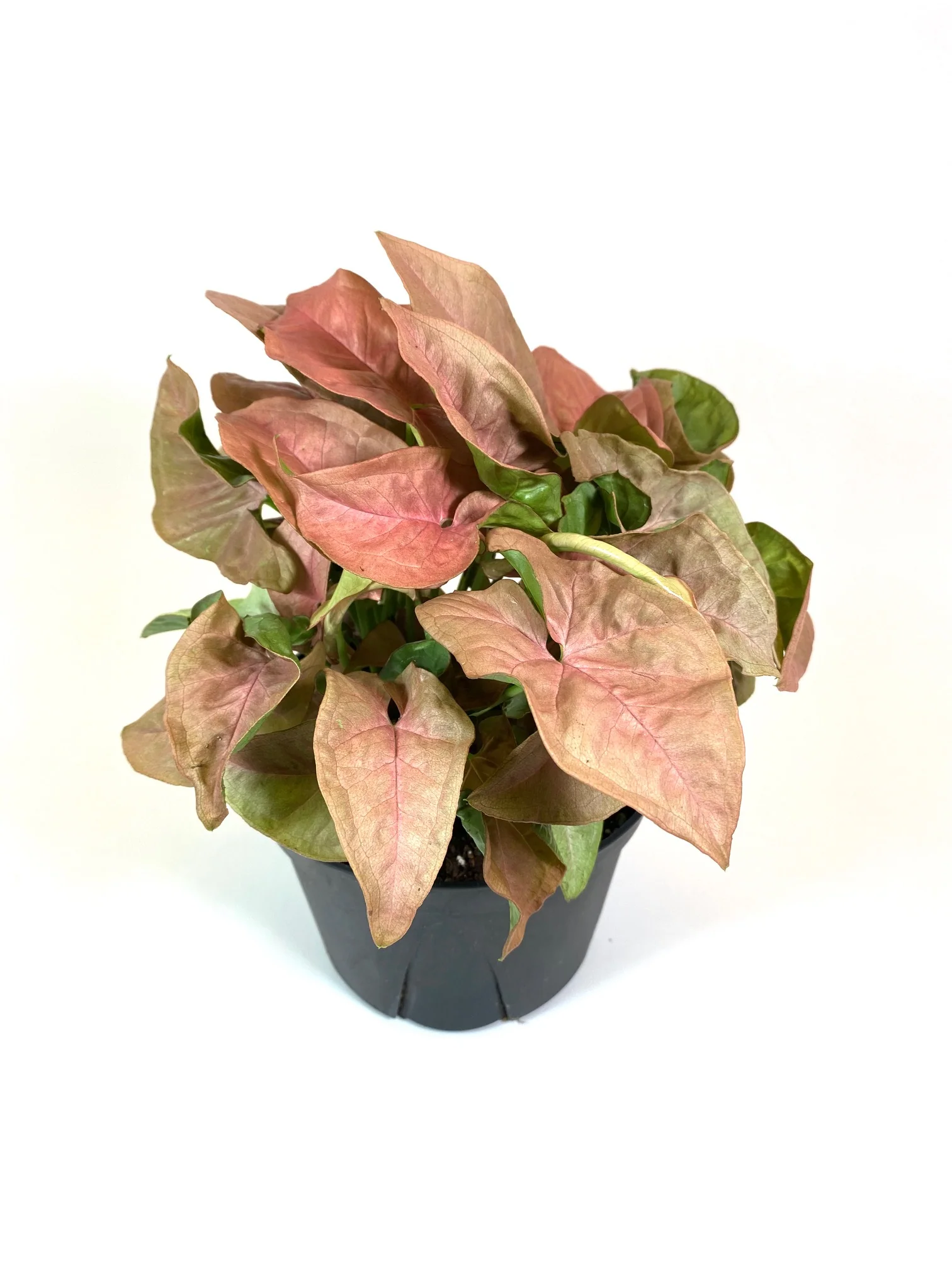
Syngonium ‘Neon Robusta': The foliage of this cultivar displays a vibrant pink coloration, making it an eye-catching addition to any plant collection.
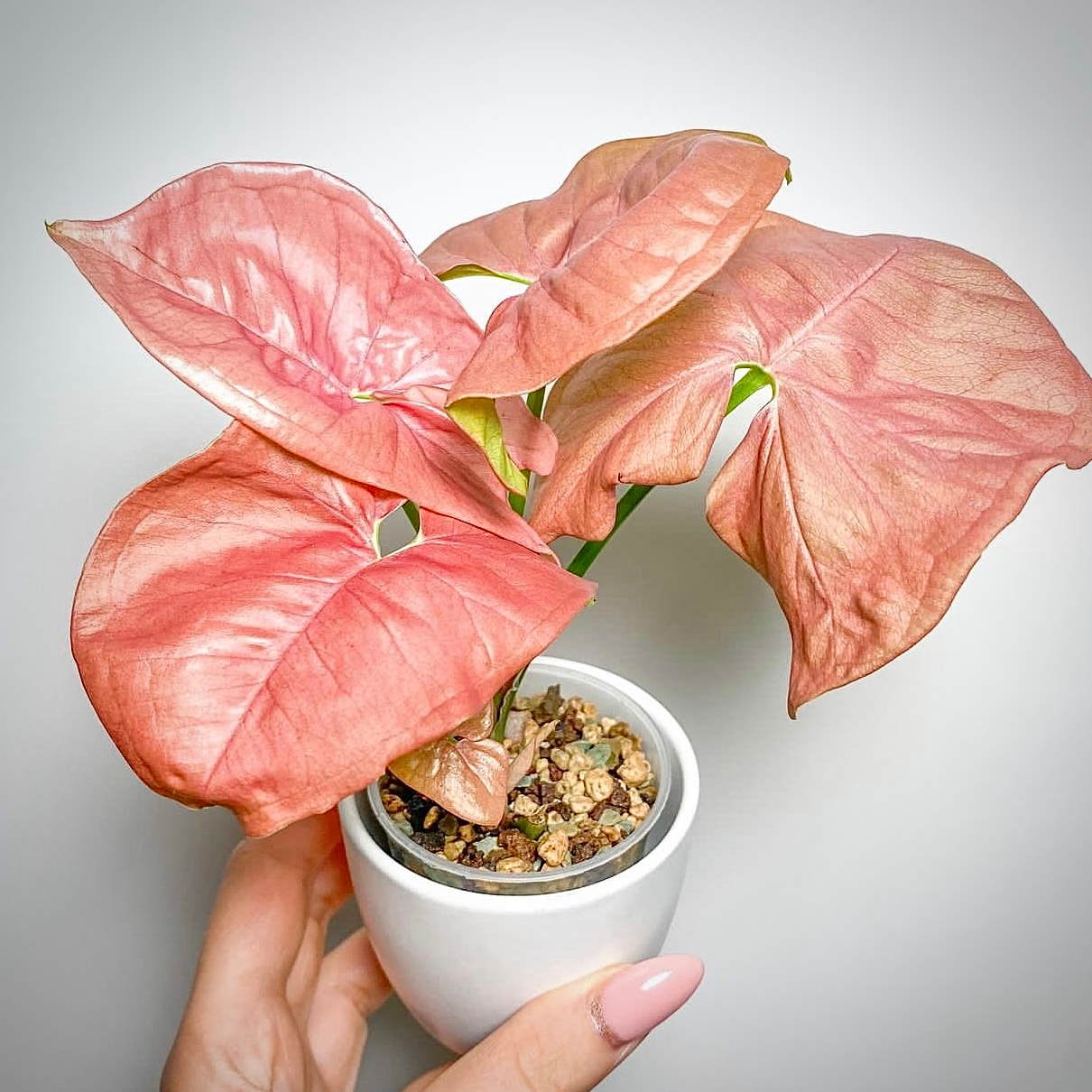
Syngonium ‘Strawberry Cream': This variety has leaves that emerge pink and gradually transition to a cream color as they mature.

Common Problems with Syngonium Pink Splash
Syngonium Pink Splash, although easy to care for, faces some common problems that many houseplants are challenged with.
Growing –
When encountering growing issues with your Syngonium Pink Splash plant, assess the soil, watering, and light conditions. Repot with nutrient-rich, well-draining soil, and relocate to a bright, indirect light spot if needed. Prevent overwatering by adding porous materials like perlite or peat moss to improve drainage.
Diseases –
Diseases can occasionally affect Syngonium Pink Splash plants, with common issues including fungal infections like root rot or leaf spot. Preventative measures such as providing proper air circulation, avoiding overwatering, and maintaining good hygiene by removing any affected leaves can help minimize the risk of disease.
Pests –
Syngonium Pink Splash plants may be susceptible to common pests like spider mites, aphids, or mealybugs. Regularly inspect the plant for signs of infestation, such as webbing, tiny insects, or sticky residue. If pests are detected, promptly isolate the affected plant, treat it with insecticidal soap or neem oil, and ensure proper ventilation to discourage their spread and maintain the plant's health.
Other Things to Know About Syngonium Pink Splash
The Syngonium Pink Splash plant is a captivating and versatile addition to any indoor plant collection. Its variegated foliage showcases a beautiful blend of pink, white, and green colors. Apart from its aesthetic appeal, this plant also offers air-purifying properties, helping to improve indoor air quality.
FAQ’s
Is Syngonium Pink Splash rare?
Yes, the Pink Splash is considered to be a rare Syngonium.
How do you care for Pink Splash Syngonium?
Maintain the cleanliness of your Pink Splash Syngonium by regularly wiping the leaves with a damp cloth or lightly misting them. This prevents dust buildup and potential pest infestations. As you care for the plant, rotate it 1/4 turn to promote balanced growth and ensure all sides receive sufficient light for a fuller appearance.
How big do Pink Splash Syngonium get?
With all the proper conditions Pink Splash Syngonium can grow up to 3-6 feet in height with a 2-foot spread.
Can Syngonium Pink Splash revert?
Yes, very low lighting can cause the Pink Splash to revert back to green-colored foliage.

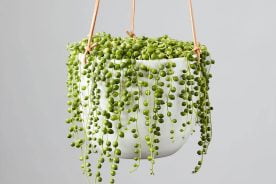

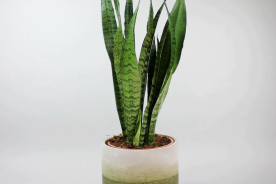

No Comments